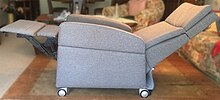Nursing chair
A nursing chair (also Riser or rehabilitation chair ) is a multifunctional tool for sitting, people with long-term care support and their carers in daily life and meeting the requirements of health care in terms of care and hygiene fulfilled. Depending on the model and design, nursing chairs offer support, stability and relief for weakened muscles, adjustability up to a lying surface, a wheelchair function and a stand-up aid. The functionality of the nursing chair should also relieve caregiving relatives and the corresponding professional groups in clinics and care facilities. Nursing chairs can increase the acceptance of care aids among those affected by their appearance, which is similar to a normal armchair.
Diseases and areas of application
Nursing chairs are designed to support people with different clinical pictures or care levels : temporarily or permanently, in a clinic, care facility or at home. They provide relief for diseases such as Parkinson's , muscle weakness or ALS and are used after heart attacks, paralysis, accidents or in Alzheimer's disease and dementia . Their fields of application range from the private sector through rehab and day clinics to palliative wards and geriatrics . Oncologies and stroke units use this tool as well as the area of assisted living and old people's homes .
features
Manual or electrical adjustability
Nursing chairs can be adjusted manually or electrically, thereby preserving the independence of its users and their participation in social life. In the case of electric versions, the adjustment function is performed by a motor that is controlled by a cable remote control so that the remote control remains firmly connected to the armchair. Care chairs are operated with batteries to ensure mobility in the living area or in the care facility.
Stand-up aid
The patient receives support when getting up by lifting the armchair or seat with a motor with a slight incline forwards. This allows users to bring their legs under the body's center of gravity and get up safely guided. In the reverse process, they are picked up while standing and then slowly lowered into the sitting position.
Wheelchair function
The equipment with floor castors, footrest (so that the person concerned can put his feet down protected while rolling) and push bar enables the functionality of a wheelchair indoors. Compared to conventional wheelchairs, which also provide mobility, but can cause problems when sitting for long periods, the muscles in the care chair are supported and prevent them from falling down.
Removable armrests and headboard
The temporary (complete) removal of armrests and headboard fulfills two important functions in care. On the one hand, it makes it easier to transfer from the care bed or stairlift to the care chair. A sliding board can often bring further relief, so that the person affected can "slide" directly from the sitting position in bed onto the nursing chair. The same applies to the transfer from the wheelchair to the care chair. On the other hand, the removal facilitates care or medical treatment without the affected person having to be moved or put in bed, since they are easier to reach for care and medical treatment is easier to carry out.
Nursing support
Professional caregivers as well as caring relatives are physically relieved by the care chair. Various equipment features such as a stand-up aid, wheelchair function or removable armrests and other modules enable caregivers to work with less effort and time.
Hygiene, disinfection and fire protection equipment
For use in clinics and other public healthcare facilities, nursing chairs are subject to strict legal hygiene regulations, from which private care also benefits. Your cover materials are moisture and dirt resistant, impermeable to water and resistant to disinfectants to prevent the growth of germs . Flame-resistant upholstery foams and covers meet all the requirements of the contract and public care sector and are certified for suitable models.
Risks
Sitting or lying down in an unchanged position for too long can lead to pressure points and pressure ulcers in the care patient.
literature
- Back-friendly care: work techniques for various clinical pictures. ISBN 9783170329706 .
- Nicole Menche (Ed.): Care Today.
- Planning and building for living in old age. Blottner Verlag, ISBN 978-3-89367-099-4 .
Web links
- REHADAT aids portal with information on all aids available in Germany; supplemented by a list of GKV aids
- https://www.sicherheites-krankenhaus.de/patientenzimmer/taetigungen/transfer-lagerung/kleine-hilfsmittel/informationen-514.html
Individual evidence
- ↑ The correct posture when getting up and sitting down from the chair. Springer-Verlag Berlin Heidelberg, 2013, accessed on May 14, 2019 .
- ↑ Correct posture in a wheelchair. Sunrise Medical, June 26, 2018, accessed May 17, 2019 .
- ^ Employer's liability insurance association: Safe hospital> Patient room> Small aids. Retrieved April 28, 2019 .
- ↑ Transfer from bed to wheelchair according to the Bobath concept. In: vitanet.de. Accessed May 2019 .
- ^ Hospital hygiene . Federal Ministry of Health, April 25, 2019, accessed on May 15, 2019 .


